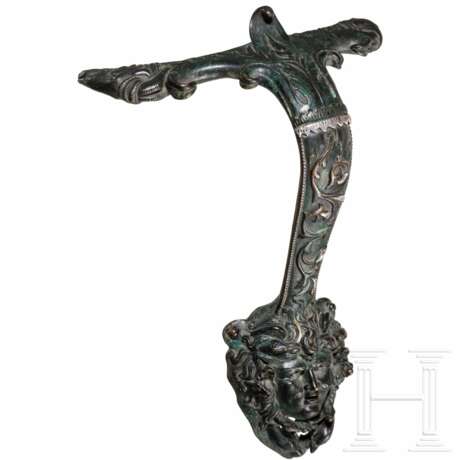ID 946754
Лот 58 | Reich verzierter bronzener Henkel nach römischem Vorbild, Renaissance, 15. Jhdt.
Оценочная стоимость
€ 4 500
Der oberste Teil des Henkels und der innere Teil der Zarge bilden eine ornamentale Einheit, die mit Akanthusblättern verziert ist, deren Enden sich rückwärts einrollen. An den Enden der Zarge je ein ausgesprochen fein ausgearbeiteter Ziegenkopf. Die anatomisch präzise Wiedergabe auf der Oberfläche nachziseliert und fein punziert, u.a. um die Fellstruktur wiederzugeben. Oberster und darunterliegender Teil des Henkels durch zwei gegenständige, schmale Akanthusstege getrennt, der untere mit Silber plattiert. Der Henkel durch einen silberplattierten Perlrand eingefasst. Auf der Oberfläche eine Wellenranke mit sich einrollenden Zweigen in Wellenbergen und -tälern, einzelne Blätter ebenfalls silberplattiert. Unterhalb des Henkels die im Umriss schildförmige Attasche mit einem Kopf, der eine Mischung aus Medusen- und Oceanushaupt darstellt. Flügel in der Frisur oberhalb der Stirn und verknotete Schlangen unterhalb des Kinns sind typische Elemente einer Medusendarstellung. Sechs seitlich aus den welligen Locken hervorschwimmende Delfine und Pflanzenblätter hingegen sind Elemente einer Oceanusdarstellung. Auf der innen und am Rand unregelmäßig geformten Rückseite der Attasche, die nicht für eine Befestigung durch Lötung oder Montage gedacht war (Pseudoattasche), eine massive, kugelige Auflage. Die Ausdruckskraft der solchermaßen vom Boden abgehobenen figürlichen Attasche wird durch diesen Kunstkniff verstärkt.
Oberfläche zur Herstellungszeit dunkelgrün patiniert. Der für ein blechernes Gefäß (so zumindest in römischer Zeit) viel zu schwere Henkel war nie für einen solchen Zweck gedacht. Von römischen Gefäßen blieben oft nur die massiveren Bronzehenkel erhalten, während die dünnen Gefäßwandungen, insbesondere bei starker Mineralisierung des Metalls im Boden, oft zerscherbt waren und unbeachtet blieben. Ähnlich wie nach dem Vorbild seltener und schöner römischer Bronzemünzen in der Renaissance stilistisch und qualitativ hochwertige Kopien erstellt wurden (sogenannte Paduaner), stellt dieser Henkel ein geradezu übersteigertes Ideal eines römischen Gefäßhenkels mit üppiger Verzierung dar, der einst die Sammlung eines Antikenliebhabers der Renaissance ergänzte, sei es ein Adliger oder ein reicher Kaufmann. Stil und Technik verraten jedoch bei genauer Betrachtung den Zeitgeist der Renaissance.
Prachtexemplar einer renaissancezeitlichen Bronzeplastik von erlesener künstlerischer und handwerklicher Qualität
Provenienz: Aus Lagerbestand einer Münchner Galerie.
A richly decorated bronze handle based on Roman models, Renaissance, 15th century
Exceptionally heavy, massive and richly decorated bronze handle, closely based on Roman models, which was probably designed as an antique-style "sculpture" without ever having been attached to a vessel. The handle is divided into three parts. The "horizontal" frame on top encircling the rim of a fictitious vessel mouth, a ribbon-shaped handle in the middle and a figuratively designed attachment at the bottom.
The uppermost part of the handle and the inner part of the frame form an ornamental unit decorated with acanthus leaves whose ends curl backwards. The ends of the frame terminate in delicately crafted goats’ heads. The anatomically precise reproduction is chiselled and finely punched on the surface, among other things, to reproduce the structure of the fur. The upper part of the handle and the part underneath it are separated by two opposing, narrow acanthus bars, the lower one plated with silver. The handle trimmed by a silver-plated beaded rim. On the surface a wavy vine with curling branches in wave crests and troughs, individual leaves also silver-plated. Below the handle the shield-shaped attachment with a head representing a mixture of Medusa and Oceanus heads. Wings in the coiffure above the forehead and knotted snakes below the chin are typical elements of a depiction of Medusa. Six dolphins emerging from the sides of the wavy curls and plant leaves, on the other hand, are elements of a depiction of Oceanus. On the irregularly shaped reverse side of the attachment, which was not intended to be fixed by soldering or mounting (pseudo-attachment), a solid, spherical support. The expressive power of the figural attachment lifted off the ground in this way is enhanced by this artistic trick.
Surface patinated dark green at the time of manufacture. The handle, which is much too heavy for a tin vessel (at least in Roman times), was never intended for such a purpose. Of Roman vessels, often only the more solid bronze handles survived, while the thin vessel walls, especially when the metal was heavily mineralised in the ground, were often shattered and remained unnoticed.
Similar to copies of rare and beautiful Roman bronze coins that were made in the Renaissance in high quality in terms of style and craftsmanship (called Paduans), this handle represents an almost exaggerated ideal of a Roman vessel handle with opulent decoration that once complemented the collection of an antique lover during the Renaissance period, perhaps a nobleman or a rich merchant. On close inspection, however, the style and technique betray the spirit of the Renaissance.
Splendid example of a Renaissance bronze sculpture of exquisite artistic quality and workmanship.
Provenance: From the inventory of a Munich gallery.
Condition: I - II
| Категория аукционного дома: | Рецепция античности |
|---|
| Категория аукционного дома: | Рецепция античности |
|---|
| Адрес торгов |
Hermann Historica Bretonischer Ring 3 85630 Grasbrunn / München Германия | ||||||||||||||
|---|---|---|---|---|---|---|---|---|---|---|---|---|---|---|---|
| Предосмотр |
| ||||||||||||||
| Телефон | +49 (0)89 5472 649 0 | ||||||||||||||
| Факс | +49 (0)89 5472 64999 | ||||||||||||||
| Комиссия | 25 % | ||||||||||||||
| Условия использования | Условия использования | ||||||||||||||
| Часы работы | Часы работы
|



